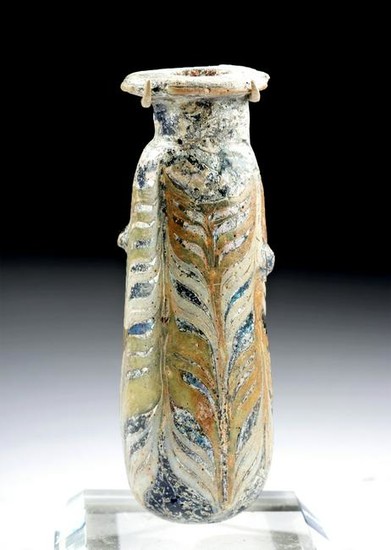Greek Hellenistic Core-Form Glass Alabastron
Ancient Greece, Hellenistic, ca. 2nd to 1st century BCE. A core-formed glass alabastron, so-named because many vessels that assumed this form were made of alabaster. The opaque bi-chrome vessel is comprised of primarily deep cobalt-blue glass with trails of golden yellow glass that have been combed into a festoon decoration and two nub handles comprised of the rich cobalt-blue glass. This particular example presents an endearing petite/near miniature size and is further adorned by beautiful silvery and rainbow iridescence. Size: 3.25" H (8.3 cm); 3.75" H (9.5 cm) on included custom stand.
The alabastron is a long-bodied vessel with a rounded bottom, a cylindrical neck, and a flat disk for a mouth. Though usually without handles, some alabastra have eyes or lugs, like this example. According to the Beazley Archive of the University of Oxford, the alabastron shape's history extends back to Corinth, but was only preserved in Athenian pottery examples back to the mid-sixth century BCE. Alabastra were created in many materials, including alabaster, and the Greek term for this stone. Alabastron (most likely of Egyptian origin) - was the source of inspiration for the name of this shaped vessel. Many examples were finished with a white ground, as if to imitate this stone. We know from vase painting imagery of women using alabastra following a bath, that these vessels most likely held perfumed oils.
According to the Corning Museum of Glass, core forming is "the technique of forming a vessel by winding or gathering molten glass around a core supported by a rod. After forming, the object is removed from the rod and annealed. After annealing, the core is removed by scraping." (https://www.cmog.org/glass-dictionary/core-forming). This process of glass making was begun in the late 16th century BCE by glassmakers of Mesopotamia, and then adopted by Egyptian glassmakers in the 15th century BCE. The technique almost came to an end in the so-called Dark Ages of Mediterranean civilization (1200 to 900 BCE); however, by the 9th century BCE a new generation of glassmakers took up the technique once again, and between the 6th and 4th century BCE core-forming spread throughout the Mediterranean.
Provenance: private East Coast, USA collection; ex-Martin J. Wunsch collection, New York, USA, acquired in the 1980s
All items legal to buy/sell under U.S. Statute covering cultural patrimony Code 2600, CHAPTER 14, and are guaranteed to be as described or your money back.
A Certificate of Authenticity will accompany all winning bids.
We ship worldwide to most countries and handle all shipping in-house for your convenience.
#146881
Condition Report: Old nicks/losses to periphery of rim. Repaired from multiple pieces. Still an amazing example with sumptuous rainbow and silvery iridescence. Tiny label reading "B" on the exterior wall.
View it on
Estimate
Time, Location
Auction House
Ancient Greece, Hellenistic, ca. 2nd to 1st century BCE. A core-formed glass alabastron, so-named because many vessels that assumed this form were made of alabaster. The opaque bi-chrome vessel is comprised of primarily deep cobalt-blue glass with trails of golden yellow glass that have been combed into a festoon decoration and two nub handles comprised of the rich cobalt-blue glass. This particular example presents an endearing petite/near miniature size and is further adorned by beautiful silvery and rainbow iridescence. Size: 3.25" H (8.3 cm); 3.75" H (9.5 cm) on included custom stand.
The alabastron is a long-bodied vessel with a rounded bottom, a cylindrical neck, and a flat disk for a mouth. Though usually without handles, some alabastra have eyes or lugs, like this example. According to the Beazley Archive of the University of Oxford, the alabastron shape's history extends back to Corinth, but was only preserved in Athenian pottery examples back to the mid-sixth century BCE. Alabastra were created in many materials, including alabaster, and the Greek term for this stone. Alabastron (most likely of Egyptian origin) - was the source of inspiration for the name of this shaped vessel. Many examples were finished with a white ground, as if to imitate this stone. We know from vase painting imagery of women using alabastra following a bath, that these vessels most likely held perfumed oils.
According to the Corning Museum of Glass, core forming is "the technique of forming a vessel by winding or gathering molten glass around a core supported by a rod. After forming, the object is removed from the rod and annealed. After annealing, the core is removed by scraping." (https://www.cmog.org/glass-dictionary/core-forming). This process of glass making was begun in the late 16th century BCE by glassmakers of Mesopotamia, and then adopted by Egyptian glassmakers in the 15th century BCE. The technique almost came to an end in the so-called Dark Ages of Mediterranean civilization (1200 to 900 BCE); however, by the 9th century BCE a new generation of glassmakers took up the technique once again, and between the 6th and 4th century BCE core-forming spread throughout the Mediterranean.
Provenance: private East Coast, USA collection; ex-Martin J. Wunsch collection, New York, USA, acquired in the 1980s
All items legal to buy/sell under U.S. Statute covering cultural patrimony Code 2600, CHAPTER 14, and are guaranteed to be as described or your money back.
A Certificate of Authenticity will accompany all winning bids.
We ship worldwide to most countries and handle all shipping in-house for your convenience.
#146881
Condition Report: Old nicks/losses to periphery of rim. Repaired from multiple pieces. Still an amazing example with sumptuous rainbow and silvery iridescence. Tiny label reading "B" on the exterior wall.



